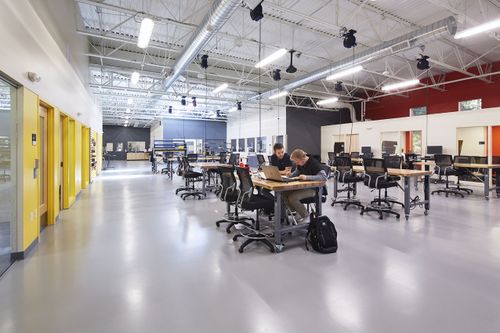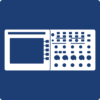Difference between revisions of "The Hub"
| Line 95: | Line 95: | ||
* Never try to operate machinery when you are tired. | * Never try to operate machinery when you are tired. | ||
* Never work in the shop with loose clothing or items that could get pulled into a machine. | * Never work in the shop with loose clothing or items that could get pulled into a machine. | ||
| + | |||
| + | == Foxtale Certification == | ||
| + | Before working with any of the equipment in the Machine Shop you will need to take the [https://foxtale.georgefox.edu/moodle/course/view.php?id=30471 general lab quiz] as well as the specific quiz for each machine you are trying to use. The enrollment code for all of the quizzes is MakerHub. | ||
Revision as of 14:33, 16 February 2021
With more than 5,500 sq. ft., The Hub contains a variety of hand tools and equipment. The capabilities include vinyl cutting/printing, sewing, electronics workbench as well as low fidelity prototyping.
The current Ace of the The Hub is ' ().
Schedule
The Hub is open 24/7 during the semester. You will need to take the Maker Hub Intro quiz to gain access.
Equipment Overview
| Name | Company | Model | Current Ace ⠉ |
|---|---|---|---|
| Electronics Workstation | BK Precision Teletronix | 2831 4 1/2 Digital Multimeter 4017A Function Generator TDS 2024 Oscilloscope 1651A DC Power Supply | Needed |
| Foam Cutter | Proxxon | Thermocut 12E & 115E | Needed |
| Heat Press | Stahls' Hotronix | Maxx20 | Needed |
| Heavy Duty Sewing Machine | Consew | 206RB | Dan Schutter (text him at 503-317-5614) |
| Mug Press | Heat Press Nation | HPN-SIG-MUG | Needed |
| Serger | Janome | MyLock 634D | Needed |
| Sewing Machine | Janome | 3160QDC | Brooke Frisk |
| Soldering Irons | Weller | WES51 | Needed |
| Sublimation Printer | Sawgrass | SG400NA | Summer Martindale |
| Vinyl Cutter | Roland | GR-640 | Summer Martindale |
| Vinyl Printer+Cutter | Roland | BN-20 | Summer Martindale |
Equipment by Icon
3 commandments
The Hub is the central room of the Maker Hub. It has multiple open tables for work, 8 computers on wheels, some smaller blue rolling tables and some semi-permanent stations. Let’s take a little time to go over these elements .
First, there are approximately 8 open workbenches that are open for general use. Each of these has a permanent home that is marked on the floor. Each of these tables should be surrounded by 4 chairs. Each of these tables is also equipped with power outlets on each leg. These are connected with cables and cable tied - please do not cut these cable ties (why has someone been doing this??? why???). There is one power plug for each table that can be plugged into the power outlet that comes down from the ceiling. These power outlets have been positioned so that that they hang directly down by the table. These tables are on wheels and can be moved. However, when you have finished with the table, please reset the space. Ensure that the table is placed back inside of the special marks on the floor, plug in the table, and make sure that the four chairs are back around the table. When you RESET THE SPACE, it makes it nice for those following behind you. And we want to be nice … don’t we? Yes is the answer to that question. If you need to leave your project out on a table, you must mark it as in use, with your Name, Team/Project, initial date, and reason for leaving it out. There needs to be a decent reason for this, and it shouldn’t stay out for more than three days. If there are special circumstances, please speak with your project advisor and/or the technician.
There are smaller blue tables that also have spots marked on the floor for their permanent homes. These tables reside on the wall nearest the quad. These tables can be used as transport tables for your projects. There are some limited storage locations in the Hub, and you can use these tables to transport your projects from these locations to wherever you might need in the Hub. When you are finished using these tables, please clear them off and put them back. If, for some special reason, you need the table to be in use for a short time (less than three days), mark the table as in use. This is useful if you want to run overnight tests or you are in the middle of an assembly. However, this is for short term use. Remember, BE PROFESSIONAL. Release the materials for others.
There are eight rolling computers that also have permanent homes at marked spaces around the HUB. They are all the same as the Computer Lab machines with the exception of numbers 7 and 8. These machines also have the Adobe Creative Suite software. Each of these 8 machines have UPS power supplies that allow you to unplug the machine and move it around the Maker Hub without powering it down. You allegedly have about 15 minutes of power available from these UPS supplies (if anyone actually times it, let us know). Feel free to use these computers wherever you want to use them … they often make their way into meeting rooms. However, when you have finished, as always RESET THE SPACE! The computers, when not in use, should always be sitting, plugged in, at their permanent locations. This is especially important if you take them into a lab or the senior design studio, or one of the other Maker Hub shops. When you have finished sitting at the machine, return it. Do not leave it in a different space. If your senior design team or lab or shop needs an extra computer, speak with your project advisor or the technician and we can address the situation. BE PROFESSIONAL!
On the wall are a set of tools. These are available for use within the Maker Hub. As should be obvious, when you are done using the tools, return them - RESET THE SPACE. For example, if you use a tool put it back when you are done. Not much of an example. Sort of hard to make this any more clear. Let’s say it is a wrench - and you use it. When you are done - put it back. Get it? The tools are marked with blue paint to indicate they belong in the Maker Hub. If you are a senior and you need tools for your project and don’t want to return them, check them out from the toolroom. If we don’t have them, speak with your advisor and we can see about getting them. In the meantime, put them back. If you are an employee and need equipment and/or tools in your place of employment, do not abscond with the tools on the wall. You may certainly use them, but you must put them back. If you want tools permanently in your shop, ask the technician and the problem can be remedied.
There is A/V equipment in the corner of the space. Best to just leave it alone. It is used for assemblies by trained professionals. You shouldn’t try this. And it is pretty boring.
There are storage shelves in the senior design corridor across from the Environmental lab. If you want to store your project there, this is fine. Just label your shelf. Feel free to use the blue carts to move it into the Maker Hub for work. We will be working more on the storage options.
Within the Hub, there are some semi-permanent workstations: Sewing Station The sewing station is located next to the Prototype Lab and consists of 2 sewing machines and 1 serger. Use of the sewing equipment requires specialized training. Vinyl Cutting Station The vinyl cutting station sits in front of the windows of the Prototyp Lab. The vinyl cutter consists of a vinyl cutter and a vinyl printer. These are useful for making signs, stickers and other fun things. Use of this station requires specialized training. In addition to the vinyl cutter, there is a large roll of butcher paper available. This does not require special training. You pull it and tear it off. If you cannot operate this piece of equipment, please leave the space and change your major. Electronics Stations There are two electronics stations currently installed in the Hub. These workbenches each contain a soldering station with soldering mat, oscilloscope, multimeter, power supply, and signal generator. Located at the end of the station is a cabinet used for holding various electronic cables and wires needed for working with equipment.
When using the electronics station, it is, as always, imperative that you RESET THE SPACE. Clean up all solder paste, stripped wires, etc., and put everything back where you found it, putting the cables back where they go.
Low-Fidelity Prototyping Station The Low-Fidelity Prototyping Station (Crafts) is provided so that students can make quick project mock-ups. Please BE PROFESSIONAL when using this station. While it might be tempting to make pipe-cleaner men as you did in elementary school, this material is provided for free to be utilized for projects, not entertainment. We will simply not be able to provide these materials if they are continually wasted.
This station also includes a laminating machine. Be careful, it can get hot (as it says in letters that are oddly small for the 21st century).
There is an end cabinet located at the end of the Low-Fidelity Prototyping Station that holds papers and materials as well as scrap cardboard. If there is room, feel free to add scrap cardboard (from shipped boxes, etc.) to keep this supply stocked.
For the other materials, if they are low or empty, please notify the toolroom so that supplies can be restocked. As always, when finished, RESET THE SPACE. Clean up the table and make sure that the bins are orderly.
General Maker Hub Knowledge
Machining is the process of removing material so it is subtractive manufacturing. We have a variety of machines in the shop.
The 3 main processes include milling, turning, and drilling.
Each machine has its own special purpose and benefits. The drill press will produce holes quickly but normally has less precision than using a milling machine. The lathe is normally used for making round parts and drilling. The metal laser is good for making fast precise cuts in sheet metal. The waterjet can cut steel up to 1" thick but it takes a long time to cut thick materials. The finger brake allows you to make bends in sheet metal. The shear is good for cutting straight lines in thin sheet metal or making smaller pieces.
Here are a few good steps to being successful in the Machine Shop.
- Make sure your workpiece is held securely before making cuts.
- Metal can be hot and sharp so always be careful when picking up material pieces.
- Make sure you you have been properly trained before attempting to use a machine.
- Keep hands away from moving parts on machines.
- Always ask if you have questions on how to do something.
Here are a couple things to keep in mind:
- Material can be very hot after machining.
- Machining can produce very sharp edges.
- Never try to operate machinery when you are tired.
- Never work in the shop with loose clothing or items that could get pulled into a machine.
Foxtale Certification
Before working with any of the equipment in the Machine Shop you will need to take the general lab quiz as well as the specific quiz for each machine you are trying to use. The enrollment code for all of the quizzes is MakerHub.





